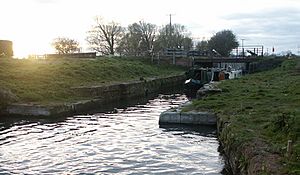Snakeholme Lock facts for kids
Snakeholme Lock is a special kind of canal lock found on the Driffield Navigation waterway in East Riding of Yorkshire, England. It's built from brick and is famous for being a "staircase lock." This means it has two lock chambers right next to each other, like steps. However, only the top part of the lock is used today. This important structure was recognized as a Grade II listed building in 1986.
Contents
Where is Snakeholme Lock Located?
Snakeholme Lock is about 0.5 miles (0.8 km) south-east of a village called Wansford. It's also around 17 miles (27 km) north of the big city of Kingston upon Hull.
- The next spot you'd reach if you went upstream (against the water flow) is Wansford Bridge.
- If you went downstream (with the water flow), the next place would be Brigham.
The History of Snakeholme Lock
Snakeholme Lock was built a long time ago, starting in 1767. This was when the Driffield Navigation canal was being dug, after a special law called an Act of Parliament was passed. It was the very first lock boats would reach on the new part of the canal. It also marked the point where the tide from the River Hull could no longer reach.
A swing bridge was built over the bottom of the lock. This bridge could swing open to let boats called Yorkshire Keels pass through without having to lower their tall masts.
Why Was a Second Lock Chamber Added?
Once boats started regularly using the new canal, people noticed a problem. Sometimes, there wasn't enough water depth over the bottom gate of the lock. This happened because the tide from the River Hull didn't always push far enough up the river. The river had sharp bends and narrow parts, which made it hard for the tide to flow in strongly.
To fix this, a new, lower chamber was built right below the first lock. This created the "staircase lock" design. The bottom lock only needed to raise boats a little bit, just enough to get them over the shallow sill. On days with very high tides or lots of river water, this lower lock wasn't even needed! A special gate called a sluice was built into the side of the chamber to let water out. Water for filling the lower lock came from the lock above it.
Later Changes and Decline
Between 1803 and 1811, more improvements were made to the canal. A new lock was built at Struncheon Hill. This new lock helped keep the water level high and steady at Snakeholme Lock. After this, it's thought that the lower chamber of Snakeholme Lock was probably not used much, if at all.
Over time, fewer and fewer boats used the canal for trade. However, some of the last goods carried on the Driffield Navigation went to the mills in Wansford. This kept Snakeholme Lock in use a bit longer than other parts of the canal. By 1967, if you visited the lock, boats could no longer pass through it, but it was still in fairly good shape. At some point, the old swing bridge was replaced with a bridge that couldn't move.
Bringing the Lock Back to Life
Through the 1980s, groups like the Driffield Navigation Ammeninties Association held occasional work parties. They helped clear away plants and keep the lock from getting completely overgrown. But it wasn't until 2002 that a special grant allowed for a big project to fix the lock and make it work again. When the lock was drained for repairs, they found the original metal part of the swing bridge's turntable in the mud! This was saved because it was an interesting piece of history.
On April 18, 2003, Snakeholme Lock was officially reopened for boats by the Mayor of Driffield. Several boats made the trip to "The Trout" pub in Wansford. However, a lot of mud has built up in the canal, and there's a fish farm right above the lock. These things have limited how many boats can use this part of the waterway. To prevent problems, the handles that open the top gate are currently locked.



